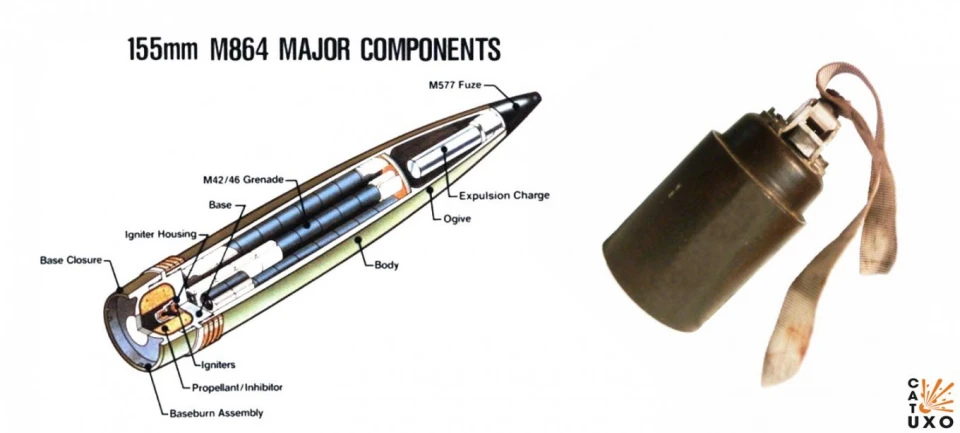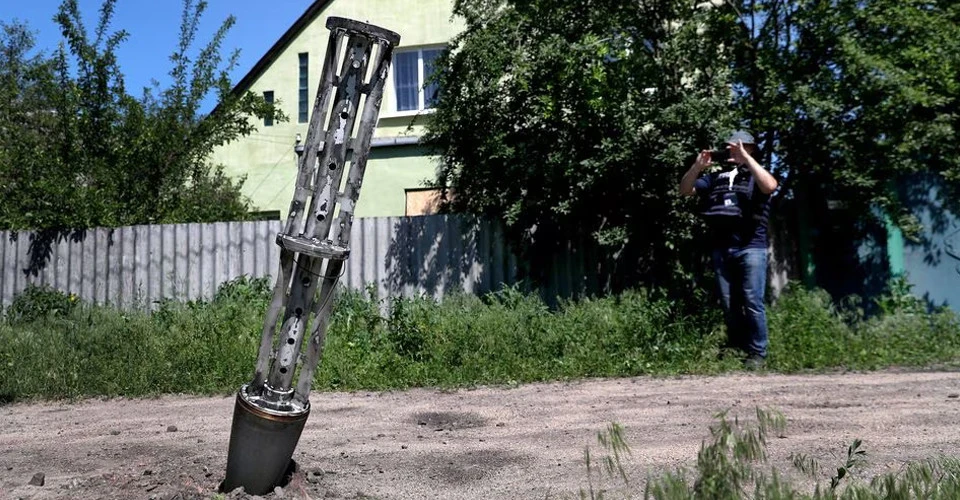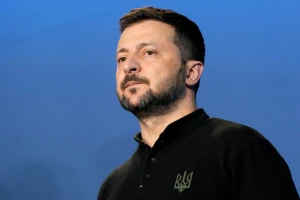
US-supplied cluster munitions: what are they and why Ukrainian Armed Forces need them
Ukraine received cluster munitions from the US. This weapon is banned in some countries, so Biden's decision to supply the ammunition caused a worldwide outcry
Espreso will explain what makes cluster munitions special, why the delivery to Ukraine did not violate international agreements, and how these weapons can help the Ukrainian Armed Forces at the front.
How Ukraine sought cluster munitions
In December 2022, Ukraine asked the United States to provide it with cluster munitions for MLRS and artillery shells. At the time, the administration of US President Joe Biden was not ready to fulfill this request and was considering it.
In February 2023, Ukraine's Foreign Minister Dmytro Kuleba called on Western allies to provide the country with cluster munitions.
Following Ukraine's initial request to the United States for cluster munitions, there was an expansion of the appeal. Kyiv specifically asked Washington for MK-20 aircraft cluster bombs with the intention of modifying them for use with drones. It was revealed that there was some level of support for Ukraine's request within the US Congress. However, the Biden administration strongly opposed the proposal as cluster munitions are banned by a 2008 international treaty.
On July 7, the US announced a new USD 800 million military aid package to Ukraine, which would include DPICM cluster munitions. The White House has received written assurances from Ukraine that it will use cluster munitions with caution to avoid risks to civilians.
On July 13, General Oleksandr Tarnavskyi, commander of the Tavria operational and strategic grouping, confirmed that Ukraine had received cluster munitions from the US.
"We have just received them (cluster munitions - ed.), we have not used them yet, but they can radically change the situation on the battlefield. The top leadership will decide on the areas of the territory where they can be used," the general said, noting that "this is a very powerful weapon."
What are cluster munitions and how do they work?
Cluster munitions are weapons that include a container holding multiple individual submunitions, also known as cluster munition units (CMUs). When deployed, these CMUs are dispersed at a predetermined height above the ground. The warheads within cluster munitions cover a wider area, causing damage across a larger zone compared to single munitions. Various types of munitions, such as aerial bombs, artillery shells, MLRS rockets, and tactical missile warheads, can incorporate cluster munitions into their design.
The US will supply Ukraine with DPICM cluster munitions, which are artillery shells equipped with cluster warheads. Specifically, the 155-mm ammunition comprises 88 individual sub-elements that can effectively cover an area measuring 300 meters in diameter. As Defense Express clarifies, this means that a single projectile can accomplish the work of numerous conventional high-explosive fragmentation shells. Consequently, the utilization of these munitions will reduce the demand for ammunition and the number of shots necessary to complete a fire mission.

DPICM M864 and M42 submunition Photo: defence-ua
Cluster munitions possess dual-purpose capabilities, combining both cumulative (anti-armor) and fragmentation (anti-personnel) properties. Some munitions may have a delayed fuze to limit the enemy's mobility. They are designed to destroy infantry and light armored vehicles in open terrain. The DPICM breaks up into dozens of smaller charges that can remain on the battlefield for years if they do not explode immediately.
"NATO planned to use such shells to counter the Soviet invasion, realizing its manpower advantage. But in 2008, the US began to abandon them for a very logical reason - there is a certain and rather small share of submunitions that do not detonate," the article explains.
Why cluster munitions are considered non-conventional weapons
The 2008 treaty banning the production, use and stockpiling of cluster munitions was adopted by 123 countries, including most of the 28 NATO members. The Convention on Cluster Munitions obliges signatory states to immediately cease the use, production and transfer of cluster munitions. Within 8 years of becoming a signatory to the Convention, countries must destroy all existing stockpiles and clear all cluster munitions from their territory within 10 years.
However, neither the US nor Ukraine has joined the convention. Therefore, the supply of cluster munitions is not a violation of international law by either the US or Ukraine. By the way, Russia is also not a signatory to the convention, as are, for example, China, India, Poland, Turkey and other countries.
Nevertheless, many consider cluster munitions to be inhumane weapons and therefore condemn their transfer to Ukraine. For example, British Prime Minister Rishi Sunak said that he "does not encourage" the use of cluster munitions, which the US agreed to send to Ukraine. The same opinion is allegedly shared by the Spanish Ministry of Defense and the Canadian government. German Foreign Minister Annalena Baerbock opposed the provision of cluster munitions to Ukraine. However, Federal President Frank-Walter Steinmeier, who signed the Convention on Cluster Munitions on behalf of Germany, supported the US decision. The UN Human Rights Office also opposed the supply of cluster munitions to Ukraine.
"Such ammunition kills and injures people long after the end of the conflict. Therefore, their use must be stopped immediately," said the Office's spokesperson.
Russian cluster munitions
The fact that cluster munitions can pose a threat to civilians was acknowledged by US President Joe Biden's National Security Advisor Jake Sullivan. At the same time, he emphasized that civilians could suffer much more damage if Russian troops and tanks seize more Ukrainian territory.
In addition, there is already a lot of submunition from cluster munitions on the territory of Ukraine.
"Russia constantly uses cluster munitions on our territory when it kills our innocent citizens, when it uses cluster shells on a regular basis," Volodymyr Zelenskyy said at the NATO summit. The President of Ukraine emphasized that the Ukrainian military will use cluster munitions exclusively against enemy military groups in the occupied territory.
Instead, Russian troops often use cluster munitions against civilians. Back in 2015, Russian forces used these shells in Syria. At that time, the international human rights organization Amnesty International accused the Russian military of killing hundreds of civilians in Syria when using cluster munitions and unguided missiles in residential areas. Russia initially denied using cluster bombs in Syria, but later even boasted about them at a specialized exhibition.
In Ukraine, Russia began using cluster munitions long before the large-scale invasion. On February 10, 2015, Russian occupying forces targeted the Kramatorsk airport with cluster shells fired from BM-30 Smerch systems. Some of the submunitions dispersed across residential areas of the city. This shelling killed 17 people, including 9 soldiers from the Armed Forces of Ukraine, and caused injuries to 64 individuals, including 5 children.
Following the full-scale invasion of Ukraine, Russian troops began employing cluster munitions from the onset of the conflict. On February 24, 2022, the Russian military launched a ballistic missile from the Tochka-U system, containing 50 high-explosive warheads, towards the city of Vuhledar. The warheads scattered near the local hospital, killing 4 civilians and injuring 10 more. On February 25, the Russian military utilized BM-27 Uragan cluster munitions in an attack on the town of Okhtyrka. Cluster munitions struck a local kindergarten, causing the death of a child.

Photo: Reuters
In March 2022, Russian forces launched cluster munitions at residential areas in Pokrovsk using rocket launchers. Throughout that month, they also employed cluster munitions in regions including Kharkiv, Donetsk, Dnipropetrovsk, Odesa, and Kherson. The UN confirmed the use of cluster bombs by Russia on March 11. Mykolaiv experienced multiple instances of shelling with cluster munitions, resulting in significant casualties. For instance, in April 2022, 10 people were killed, and 46 others were injured due to such shelling. Furthermore, a devastating attack on the Kramatorsk train station on April 8, 2022, involving cluster munitions, caused the deaths of 61 people (including 7 children) and injured 121 individuals (16 children).
In addition to the immediate dangers of shelling, unexploded ammunition poses a significant ongoing threat. Tragically, in April 2022, a father and son in Kryvyi Rih lost their lives when they brought a shell home (April 2, 2022). Similarly, in the Dnipropetrovsk region, a 12-year-old boy was killed by the detonation of a cluster munition, and another individual suffered fatal injuries while handling a cluster shell.
However, it is important to acknowledge that Russian cluster munitions present a greater risk compared to American ones in terms of unexploded ordnance. According to CNN, US cluster munitions have a notably low rate of unexploded ordnance, estimated at 2.35%. In contrast, at least one in four Russian cluster munitions fails to detonate immediately, and in some instances, the malfunction rate of Russian weapons can reach as high as 40%. Consequently, Russian cluster munitions pose a significantly greater threat to civilian populations after the cessation of hostilities, with a potential risk at least ten times higher than that of American cluster munitions.
How cluster munitions will change the frontline situation
Cluster munitions can compensate for the shell deficit experienced by the Ukrainian military. This is emphasized by both military experts and representatives of the President's Office. For example, the head of Ukraine’s Office of the President, Mykhailo Podolyak, wrote on Twitter: "Cluster munitions are extremely important for Ukraine. They somewhat compensate for our shell deficit and partially restore parity on the battlefield…And actually Russia should be talked to only in a language it understands - commensurate force..."
One cluster artillery munition can replace 10-15 conventional ones. The US and EU stockpiles of ammunition may be enough for 3-4 months of active combat, Defense Express CEO Serhiy Zgurets told Espreso. The expert noted that Ukraine's main interest is in 155-mm ammunition, which is stocked in the US and Europe at about 3 million rounds. Zgurets called this amount colossal, because for the entire period of hostilities, the Americans provided Ukraine with about 2 million rounds of ammunition.
According to military expert Valeriy Riabykh, the introduction of cluster munitions onto the battlefield will swiftly shift the balance in favor of the Ukrainian Armed Forces, leaving the Russians with little opportunity to establish a lasting foothold in Ukraine.
"It is ten times more effective than conventional ammunition. Within a range of 300 meters, it leaves no chance for survival, let alone continued resistance, for the occupiers. The use of this ammunition would eliminate the problem of rapid wear of barrels due to the excessive use of artillery shells," emphasized Riabykh.
Cluster munitions will help to level Russia’s advantage in personnel, said military expert Serhiy Hrabskyi. He noted that cluster munitions will allow the Ukrainian Armed Forces to save energy and the lives of servicemen, who are now actually conducting clearance operations, actively dislodging the enemy from entrenched positions. Furthermore, the deployment of cluster munitions is expected to have a demoralizing effect on the enemy, the Ukrainian Armed Forces believe.
"What is a cluster munition? We can launch it from a distance of 25 kilometers, from positions that the enemy cannot see. This is a very demoralizing factor. With a single round, we can inflict a damage that is 5 times stronger than a single shot from an automatic weapons system. We have the opportunity to target and dismantle their rear," Yevhen Ievlev, a fighter with the Ukrainian Armed Forces, told Espreso.
- News














































